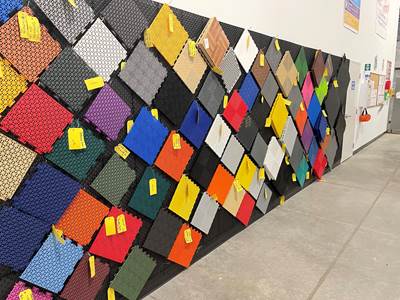The Cost of High Employee Turnover in Injection Molding: Why Retention Matters
Starting in molding in 1993 and clocking in for nearly every job on the floor over the intervening decades, I’ve seen all sides of the hiring, training and retention process in the industry. Here are my thoughts on how to keep your most important asset — your people.
Have you ever worked in a company where employees come and go like the wind? It can be frustrating, right? High employee turnover is not just annoying; it’s also expensive. In the injection molding industry, retaining your key talent is critical to success. The cost of high employee turnover in injection molding cannot be ignored. From training new hires to lost productivity, every aspect of your business will suffer if you don't prioritize retention. So why does retention matter so much, and how can you keep top talent engaged? Let's dive into this crucial topic together.
Barriers to Retention
Injection molding is a critical process in the manufacturing industry, and retaining experienced and qualified personnel is essential to maintaining a high level of quality and productivity. Unfortunately, the injection molding industry faces significant challenges in retaining employees.
One of the biggest challenges is the nature of the work itself. Injection molding can be repetitive and physically demanding, which can lead to boredom and burnout. Additionally, many injection molding facilities are located in remote or rural areas, which can make it difficult to attract and retain workers.
When employees feel like they have a say in how things are done at the company, they are more likely to be invested in its success.
Another challenge is the low wages often associated with injection molding jobs. While some companies are able to offer competitive salaries, others may not be able to afford to do so. This can lead to high employee turnover as workers move to other industries in search of better pay and working conditions.
The highly technical nature of injection molding can make it difficult to find qualified workers. Many positions require specialized training and experience, which can limit the pool of potential applicants. As a result, companies may have difficulty filling vacant positions, leading to extended downtime and lost production.
The cost of high employee turnover in injection molding can be significant. Not only does it lead to lost productivity and lower quality products, but it also increases costs associated with recruiting and training new employees. For these reasons, it is essential for companies in the industry to focus on retention strategies that will help them keep their best workers for the long term.
The Cost of High Employee Turnover
The high cost of employee turnover is a huge problem for injection molding businesses. Not only does it cost money to replace employees, but it also disrupts production and can lead to lower quality products.
There are a number of reasons why employees may leave an injection molding business, but the most common is dissatisfaction with their job. This can be due to a number of factors, including low pay, long hours, poor working conditions or a lack of opportunity for advancement.
When an employee leaves, it costs the business money in a number of ways. First, there is the direct cost of recruiting and training a new employee. Second, there is the indirect cost of lost productivity while the new employee gets up to speed. And, finally, there is the opportunity cost of not having an experienced employee on staff.
The best way to reduce the cost of employee turnover is to focus on retention. This means creating a work environment that employees enjoy and providing opportunities for them to grow within the company. By doing this, you’ll keep your best employees around longer and save yourself a lot of money in the process.
Reasons for High Employee Turnover
Injection molding is a complex and demanding process that requires skilled workers. Unfortunately, the turnover rate in this industry is notoriously high, which can be costly for employers. There are a number of reasons for this high turnover, including:
- Low wages: Many entry- and mid-level injection molding jobs are low paying, which makes it difficult to attract and retain workers.
- Poor working conditions: Injection molding can take place in a dirty, hot and noisy environment, which can be tough to work in on a day-to-day basis.
- High stress levels: The demands of the job can be very stressful, which can lead to burnout and turnover.
- Limited advancement opportunities: Due to the nature of the work, there are often limited opportunities for advancement, which can be frustrating for employees.
Strategies to Decrease Turnover
There are a number of strategies that employers can use to decrease turnover in their injection molding businesses. Some of these include:
- Offering competitive pay and benefits: In order to attract and retain workers, it is important to offer competitive pay and benefits. This may include things like health insurance, paid time off and retirement savings plans.
- Providing training and development opportunities: Employees who feel like they are constantly learning and growing are more likely to stick around. Providing opportunities for training and development shows employees that you are invested in their future with the company.
- Creating a positive work environment: A positive work environment goes a long way in keeping employees happy and engaged. Things like open communication, respect and appreciation can go a long way in making employees feel valued at work.
- Encouraging employee input: When employees feel like they have a say in how things are done at the company, they are more likely to be invested in its success. Encouraging employee input shows that you value their opinions and want them to be a part of the decision-making process.
- Recognizing achievements: Employees who feel appreciated for their hard work are more likely to stick around. Showing your employees that you notice and appreciate their efforts will make them feel valued, which will increase retention rates.
From training new hires to lost productivity, every aspect of your business will suffer if you don't prioritize retention.
It is clear that employee turnover in injection molding can be costly to both the company and the broader industry. Companies should focus on creating a positive workplace environment, offering competitive salaries and benefits, providing extensive training opportunities, and engaging with their employees through effective communication. By doing so, companies will be able to reduce employee turnover rates while increasing efficiency and profitability in the long run. With these strategies in place, employers can ensure they are retaining their most valuable asset — their employees!
About the Author: Rodney Davenport is vice president at CH3 Solutions, an injection molding company in Dalton, Ga. He has more than 20 years of experience in the industry. Rodney grew up in Michigan, moved to Florida and started his career in injection molding there. Rising through the ranks through hard work and a helpful attitude, his passion for technology helped propel him further as he learned new processes and technologies throughout his career. In April 2015, Davenport helped establish CH3 Solutions as a brand new injection molding company.

Retaining employees who’ve completed the application, onboarding and training processes is key to an injection molder’s commercial success. Photo: iStock
Related Content
A Simpler Way to Calculate Shot Size vs. Barrel Capacity
Let’s take another look at this seemingly dull but oh-so-crucial topic.
Read MoreKnow Your Options in Injection Machine Nozzles
Improvements in nozzle design in recent years overcome some of the limitations of previous filter, mixing, and shut-off nozzles.
Read MoreHow to Set Barrel Zone Temps in Injection Molding
Start by picking a target melt temperature, and double-check data sheets for the resin supplier’s recommendations. Now for the rest...
Read MoreAre Your Sprue or Parts Sticking? Here Are Some Solutions
When a sprue or part sticks, the result of trying to unstick it is often more scratches or undercuts, making the problem worse and the fix more costly. Here’s how to set up a proper procedure for this sticky wicket.
Read MoreRead Next
Injection Molder Bases Company Culture on Employee Empowerment
After more than two decades in the industry, Rodney Davenport was given the opportunity to create an injection molding operation in his own vision, and — in keeping with the product he was making — to do so from the ground up.
Read MorePlastics Processors Who Hire ‘Second-Chance’ Workers Do Well by Doing Good
Two blow molders with long-standing programs of hiring formerly incarcerated low-level offenders have helped these individuals re-enter their communities and have benefited from an additional resource during chronic labor shortages.
Read MoreLead the Conversation, Change the Conversation
Coverage of single-use plastics can be both misleading and demoralizing. Here are 10 tips for changing the perception of the plastics industry at your company and in your community.
Read More












.png;maxWidth=300;quality=90)
















